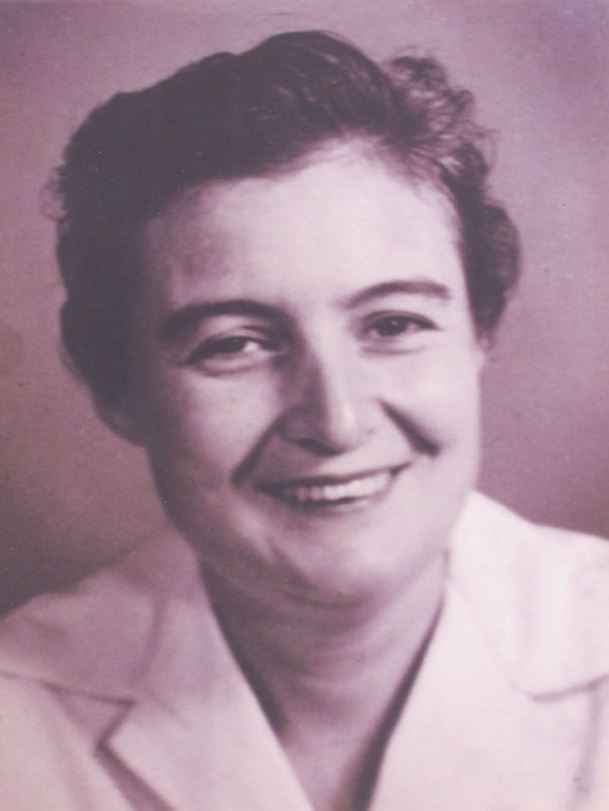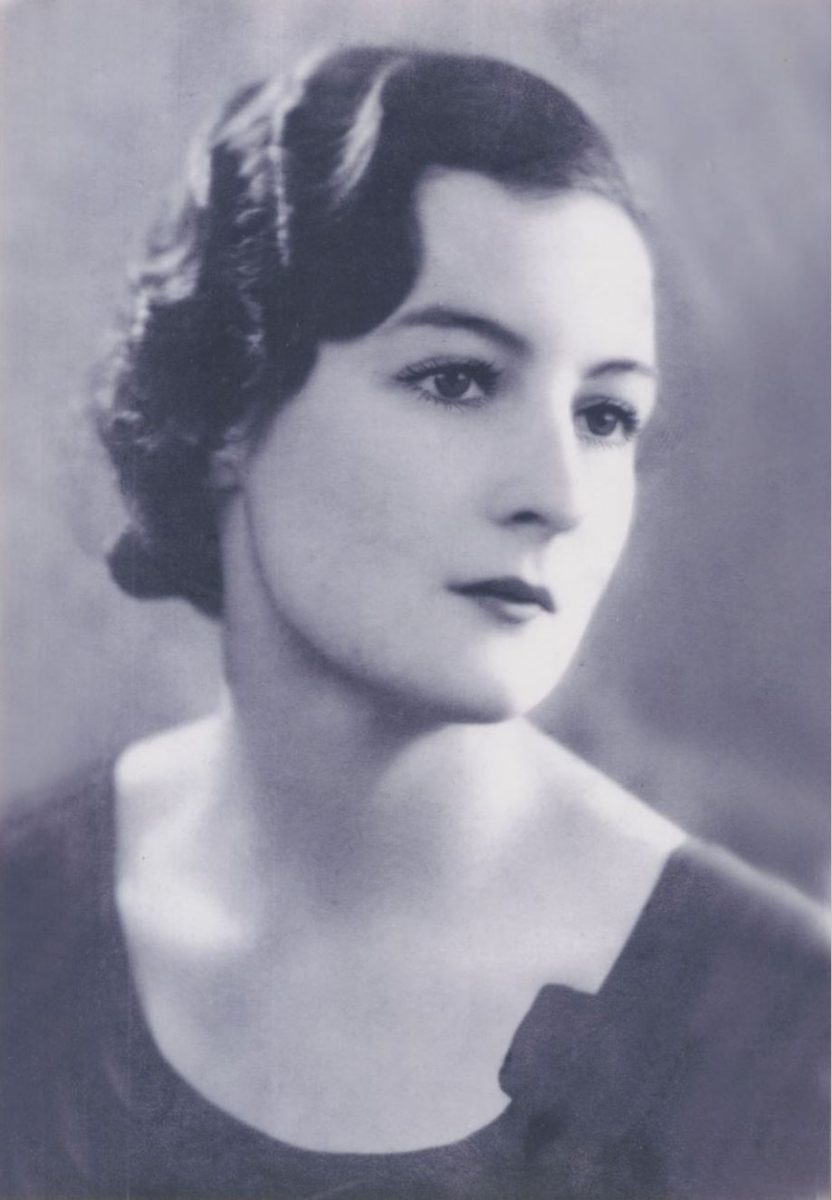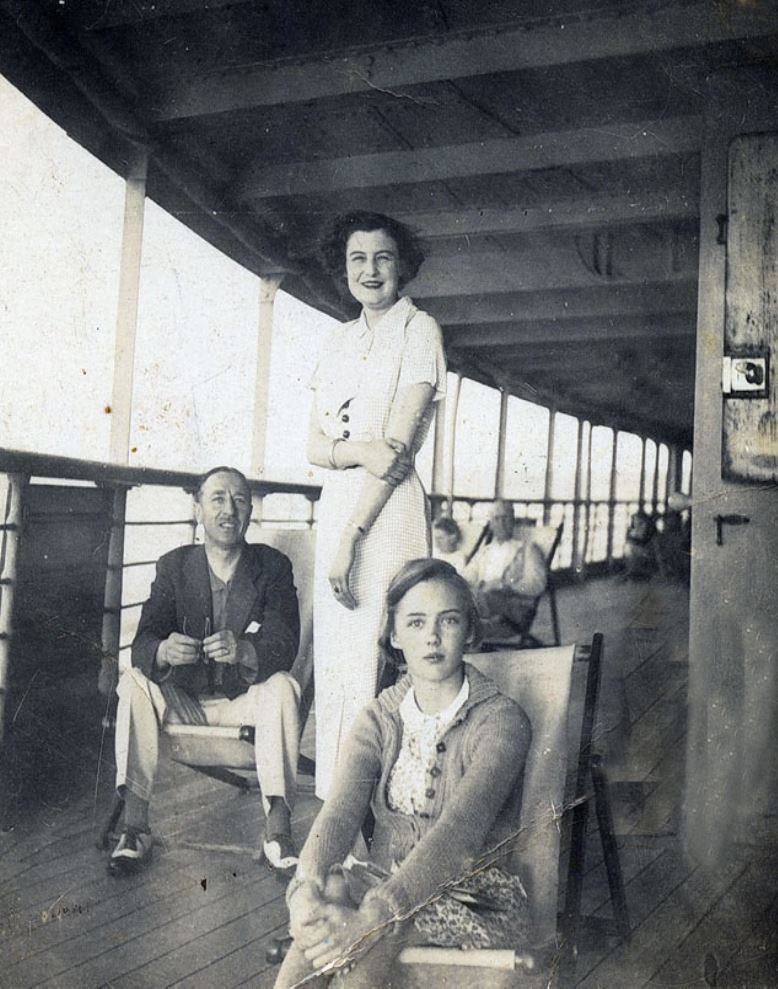Ethel Lovegrove and Laurence Marshall Pinto first met under the Big Clock at Charing Cross Station in the “City of Spires” (London) on 27th April 1932; one day after “Laurie’s” 25th birthday. Charing Cross Station is one of the oldest undergrounds in London situated in a charming area of the city surrounded by antique bookstores. Ethel (Mona) was just 20 years old then. They were, of course, properly chaperoned by Mona’s sister, Ivy, and a fellow Indian student and friend of Laurie’s from Goa, Frank Moraes. Frank was an Honor Society Student at Oxford and Laurie was studying engineering at London University. Mona worked at the Gas and Light Company as a secretary (her co-workers nicknamed her “Mona” because she was always “moaning” about the draft in the office. The name stuck.) The girls were busy trying to sell tickets for a benefit performance of Gilbert and Sullivan’s “Trial by Jury” that her company was producing for charity and a friend had some contacts with Indian students. Mona called Laurie about purchasing tickets and he liked the sound of her voice so much that he asked her to meet him personally to sell the ticket; they both agreed to wear red roses for identification. They were smitten and a most unique destiny was about to be forged between these two very attractive young people.
Mona was born to Ethel May and Augustus Charles Lovegrove on 11-11-11 (the Mother had spoken about this auspicious and unusual birth date in a volume of The Agenda). The Lovegroves lived in the Poplar section of London and were members of the Anglican Church. Augustus was an electrician and eventually went to fight in the First World War leaving Ethel May behind to care for three small little girls. He fought in the famous 1916 Battle of Dardanelles (ancient name, Hellespont) on the border of European and Asiatic territory. He cut a handsome figure as a young man and can be seen in a photo in the family album in full military regalia mounted atop a camel! During the war period he was missing after a battle for some time and there was no communication with his family. The British Government was unhelpful in the situation (as was the case with many) and the young mother suffered and often went without food for herself to be certain her children were fed. She learned the millinery trade and became a milliner in order to survive and earn enough money to care for her children. Finally, Augustus was found and returned home from the war to be reunited with his family. Eventually three more children were born. All the children adored their mother and set her up as the prime example of everything good that they had learned in life. Mona had been smart, winning scholarships at school and although her father was strict the family was quite open and less conservative than the Pinto family. Mona’s father, however, always insisted that she marry an Englishman only! Their plans to marry were therefore a disturbance to both families and it was only possible or Mona to leave England after her father passed away. It was unthinkable for the Pinto family who were wealthy, (Mr. Pinto bought and sold properties) upper class Catholics from Hubli near Goa, to let their son marry a non-Catholic girl. Mona had to agree to convert to Catholicism in order to marry Laurie.
Mona set sail on S.S. “The Viceroy of India” in January of 1937. Laurie had set up a business in Pondicherry three years earlier (a gelatin business in partnership with Monsieur Gaebele from one of the oldest French families to settle in the former colony). Mona was only 25 and had left behind all that was familiar to her for her marriage and new life in India. The British Raj still ruled and it would be another ten years before India would see its independence. On the journey to India she was chastised by some Englishmen aboard the ship for her decision to marry an Indian and move to India. She had brought along her beautiful, white wedding gown and had expected that there would be many guests attending her wedding which took place on 6 February 1937 at
Pondicherry’s Notre Dame Des Anges Catholic Church. However, only one member of the Pinto family attended . . . a brother. No jewelry nor family money was given to the bride and groom and when it came time for the wedding photo Laurie had to set up the camera and then dash back into place next to his bride for the picture. It is even said that an uncle had suggested to Mr. Pinto that he send a telegram to Mona in England saying “the wedding has been called off” and sign Laurie’s name to it! Of course he could not bring himself to do this. In any case, these were the conservative times and traditions were strong.
In the beginning her new life in India was not as she had anticipated. It was not altogether the romantic land of jasmine, roses, elephants and peacocks that she had always read about in books. Mona said, “India has the best and the worst of everything.” She further stated “it is sad that India was not allowed to rise to its greatest heights.” Mona told me that India should have accepted the Cripps Proposal (Sir Stafford Cripps, an English Statesman, was a Minister in the national government under Churchill during the war. His proposal was that India should accept to become a member of the British Commonwealth, allowing for self-government without full independence, rather, a stepping stone toward ultimate full independence). Mona said that Sri Aurobindo had encouraged the Indian government to do this, even sending Doraswami as a representative from the Ashram, but she said “India would not listen to its great minds, and if they had done so there would be no Bangladesh, no Pakistan, no massacres and no famine today.”
In any case Mona made the best of everything and Laurie’s business was doing well. They had many friends from the Ashram and entertained them frequently in their home. When Mona was six months pregnant Amal Kiran arranged a darshan for them with Mother and Sri Aurobindo. Mona had been educated in a Catholic convent in England and all the talk about the “Divine Mother” in Pondicherry gave her a preconceived idea of a Reverend Mother and the mental image of a Mother Superior or someone who looked like a nun. She told me she was absolutely stunned when she saw the Mother for the first time looking so gracious and beautiful and wearing light makeup. This was August 1937 and their baby girl, Judy Ann, (later to be named Gauri) was born 16 November 1937. By this time there was no question that Laurie had turned inwardly to Mother and Sri Aurobindo and all of their lives were about to be forever changed (Laurie would eventually give all his money to the Mother, become a full-time Ashramite, begin his work for Harpagon and have his name changed to Udar).

Mona Pinto had told me before I began the interview not to ask her any questions about the yoga or sadhana. She said, “I do not practice sadhana, I just came to Pondicherry to marry an Indian!” I reminded her, however, that she had been telling me this story for nearly 35 years! Of course, I consider Mona to be one of the most dedicated karma yogins that I have ever met. One only has to look at a photograph of Mona handing something to the Mother or receiving something from the Mother. Her body and her gestures speak the language of love, devotion, giving. Mona said to me, “I didn’t have to talk about nor analyze anything. I just accepted it.”
As destiny would have it, the Mother was planning the building of Golconde as a place for sadhaks to live in a meditative and peaceful atmosphere. She needed someone to organize and manage this project. Datta (Dorothy Hodgson, the Englishwoman, whom Mother met in Japan and who would become her good friend and accompany her to Pondicherry (had seen the home of Mona and Udar. She told the Mother how immaculately clean everything was in their home. The Mother arranged an interview with Mona. Later, after seeing Mona, the Mother said to Datta, “Are all Englishwomen as pretty as Mona Pinto?” Mona, a stunningly beautiful, slender, porcelain-skinned young Englishwoman so impressed the Mother that she was given the job as manager of Golconde. She was in her early 30’s then and even at her current age of 89 she is still managing Golconde with as much enthusiasm as if the work had just been handed to her. She goes there on a daily basis in the mornings to attend to all the details and I saw her at her desk in the afternoons at home pouring over and balancing the account books for Golconde. Her energy is remarkable, indefatigable. Her self-effacing humility and sense of duty are most inspiring. She told me that she is her happiest when she goes to Golconde. She said, “I served the Mother and I am still serving her and am very happy to do so, but it was so much easier when the Mother was here, so much easier. I used to go once a fortnight to clean Mother’s refrigerator. When Mother was here it was quite a different Ashram. She worked like no one else could work. She built the ashram herself.”
Mona told me that in the beginning she was reluctant about the work. She had a problem after delivery and Udar had to carry her upstairs most of the time. She said in those days, however, Golconde only had one floor. She began the work and soon got better and in time could run up and down the stairs. She personally trained all the young ladies who were to work with her. Mona said that the Mother told Satprem, “Mona Pinto likes to do things and do them well. I never have to worry about Golconde. Things always go well there and I don’t worry.” Mona said, “I was a proper Englishwoman who knew how to serve tea, how to set a proper table, when to use the right dishes, etc. Mother knew she could rely on me for all these things.”
I asked Mona to tell me some of the experiences she had with the Mother. She told me that after her baby was born her chronic back pains worsened. One day she was suffering terribly with the pain in her back. She said the Mother ran her fingers very slowly down her back and after that there was never any more pain. The same thing happened, she said, when her arm was riddled with pain and she could not even lift it. The Mother massaged the arm and “poof,” Mona said, “Gone. No more pain!” The Mother told Mona not to speak too freely about the healings. She said that there were always mischievous spirits in the atmosphere ready to play their tricks and so to just be quiet about it. Mona said, “I had a practical, down to earth relationship with the Mother. We spoke in an earthly way with one another about the work and often times just as one woman to another. She was the most gracious and beautiful lady I ever knew.”
Anie: How did the tradition of celebrating Christmas develop in the ashram?
Mona: One year Udar and I set up a Christmas tree in our house (the Red House). Nishta (Margaret Woodrow Wilson) and other westerners came. Nishta made a large star and Udar put it on the top of the tree. Later people went to the Mother and told her about it. She said, “Could it not be done for all the children?” The Mother said that Christmas had come from very ancient traditions. The wise men of the time observed that the days were growing shorter and shorter. People became worried that they would be engulfed in darkness. Then they began to notice that around the end of the month the days had begun to grow longer and that there was a return of the light. Christ’s birth ultimately became fixed to this time of the year as a symbol of the return of the light.
So, the children began to come to our home in 1943. Games were set up in our garden and prizes were given out, hats were made and everyone wore a paper hat. All were made by Golconde residents. Even special crowns were made for Sri Aurobindo and the Mother. Dyuman used to come out in the streets and blow a trumpet on Christmas day and a special hat was also made for him. Finally the tradition moved to our current house on Rue St. Gilles and then to the Playground and on to the Theatre when it was built. The Mother went to the Theatre and sat in a chair and distributed gifts to everyone. The event remains a joyous celebration in the Ashram and each Christmas day a tree is set up and decorated by the staff of Golconde. Gifts are distributed to all ashramites and guests of the Ashram. The Mother’s chair remains in the spot where she always sat.
Anie: Did you see Sri Aurobindo in his Mahasamadhi?
Mona: Yes, in the end I was working in the Mother’s room. I went to see Sri Aurobindo. He was surrounded by a light and a golden aura. I saw it myself the same as everyone else had seen it. The Mother announced that after five days the light had begun to recede and she told Udar to make arrangements to inter Sri Aurobindo’s body. Udar did not want to do this but of course he followed the Mother’s instructions.
Silence…
After this brief interview with Mona Pinto, it wasn’t possible for her to give me any more time. Christmas day was fast approaching and her responsibilities were mounting in preparing all the gifts and decorations and details for the event.

Mona and Udar Pinto, in their inspiring journey of the soul, played a most vital role in helping to establish the Mother’s and Sri Aurobindo’s Ashram. In the beginning their youthful energy, organizational skills, education and expertise, on so many levels, were essential elements in helping to frame the very foundations and infra-structure that were necessary for building a solid base for all the sadhaks who were arriving and for the work and life that was forming there. They will always be remembered with great affection and love by many in the Ashram and around the world.






